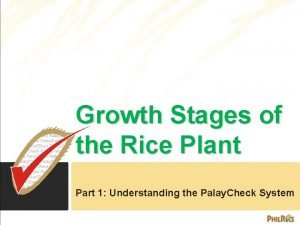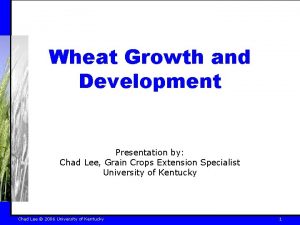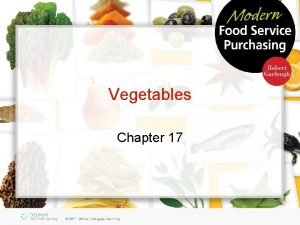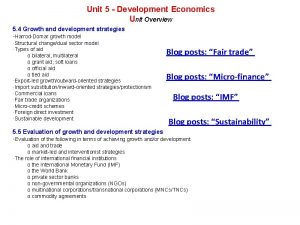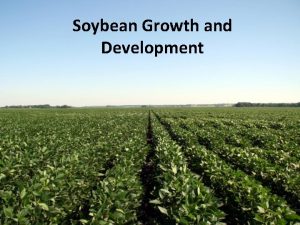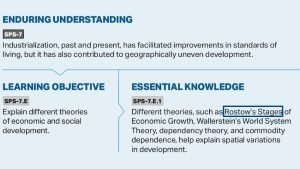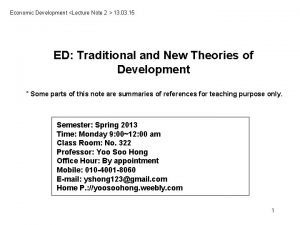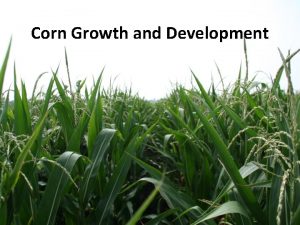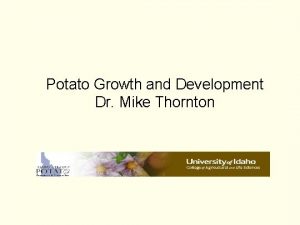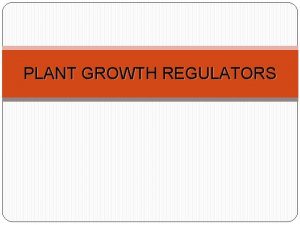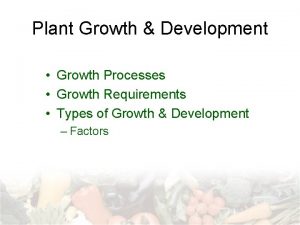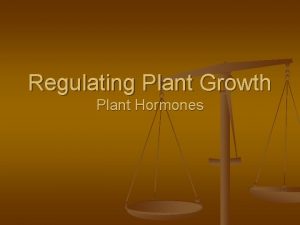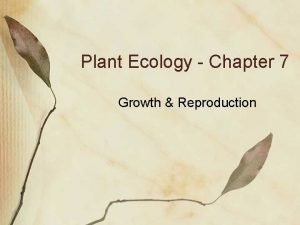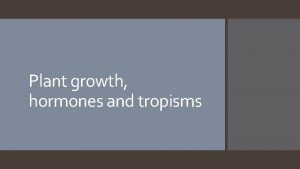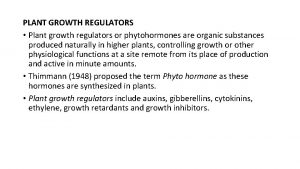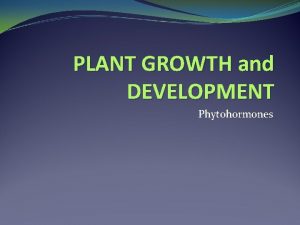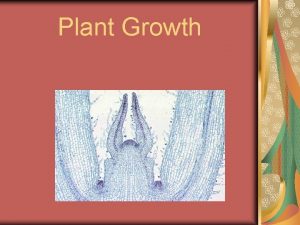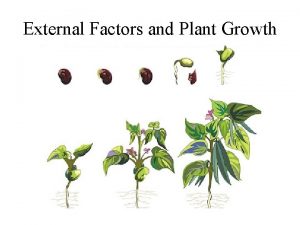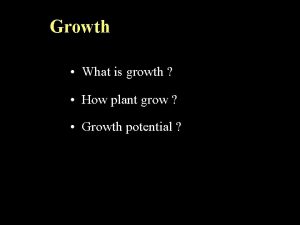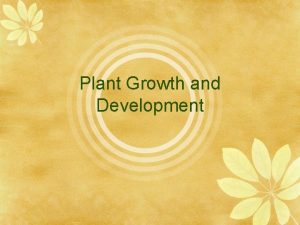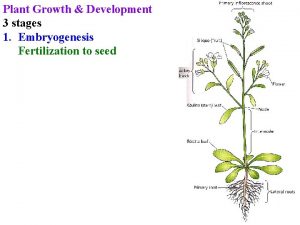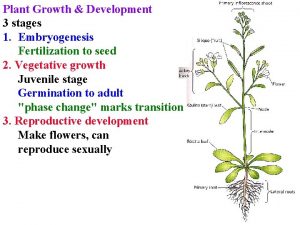TYPES OF PLANT GROWTH Main stages in a


































- Slides: 34

TYPES OF PLANT GROWTH ØMain stages in a plant’s life cycle ØPlant Growth Patterns

The Life Cycle of a Plant seeds Flower and fruit/seed production Seeds germinate Foliage stem and root formation

Plant growth Patterns Annuals- plants complete their life cycle in a single season. Biennials-plants complete their life cycle over two seasons. Perennials- plants live for longer than two seasons.

Annuals Cosmos bipinnatus(Mexican aster)

annuals v Completes life cycle in a single growing season. v Experience dormancy only as a seed as they dies during autumn or winter. v. The life of an annual can be prolonged by removing spent flowers(deheading).

Life cycle stages of annuals Seed germination Grow roots Produce stems and foliage Senescence( death) Produce seeds Produce flowers

� The plants we use in our gardens come from all over the world, therefore some plants that are perennials in one climate, such as tropical, are not hardy in our temperate climate. These plants are generally used as annuals in northern climates since they succumb to the cool temperatures of our winters. If their seeds are cold-hardy, they may germinate the next spring, depending on the severity of the winter. However, for practical purposes we treat these plants as if they were annuals.

Hardiness designations Abbreviation Name Description A Tender Annuals Plants and seeds are not frost hardy. HHA Half Hardy Annuals Plants will tolerate some frost. HA Hardy Annuals Plants may tolerate some frost. Seeds overwinter and self -sow.

Winter annuals ž ž Germinate in autumn, bloom in late autumn, winter or early spring and die the following summer. Examples: ØStellaria media(chickweed) ØLamium amplexicaule (henbit) ØBarbarea sp. ( bittercress ) ØSecale cereal(winter rye)

An important point �Sow annual seeds directly in the soil(direct sowing) if they are hardy, usually after the frost is no longer predicted. Most tender annuals are better sown indoors as they need warm soil temperatures to germinate and would not have enough time to mature in our climate if sown directly.

Biennials Digitalis purpurea(foxglove)

Biennial plants need all or part of two growing seasons to complete their life cycle as they require a cold period before they will flower. That is why they flower in the second year, not the first.

Germination from seed. Life cycle of Biennials. Senescence Root growth Seed production Formation of rosette Flower production Dormancy over winter

Biennials germinate from seed, produce foliage then become dormant during the winter. In spring they produce an abundant amount of seeds, then the parent plant usually dies. Biennials are known as profuse seeders and it is these seeds that continue the cycle

Generally, most biennials have very short, compressed stems(crown) with leaves low to the ground forming a rosette. The flowers are usually borne on a long stem that emerges from the centre of the rosette. Biennials are often propagated by seed.

Examples of biennials v Foxglove(Digitalis purpurea) v Sweet William(Dianthus barbatus) v Hollyhock(Alcea bienni) Biennial veggies: v Beets v Carrots v Parsley v Parsnips v Cabbage v Kale

Herbaceous Perennials �Periennial plants live for at least two growing seasons and produce non-woody growth that dies down in autumn as they enter their winter dormancy. In spring they emerge once again sporting new growth.

Life cycle Germination from seed. of Herbaceous Perennials Senescence after many years Root growth Seed & Flower production Foliage Growth Spring: New foliage , more roots, larger colonies May produce flower and seed Dormancy over winter

Some don’t produce above-ground stems, such as irises, they only produce foliage. Although they don’t get taller as the years progress as trees do, their roots multiply forming large colonies. A litle clump of daisies easily becomes a massive grouping, hence the appeal of herbaceous perennials.

Examples of herbaceous perennials Hosta Chrysanthemum Columbine Daylily Delphinium

Monocarpic Plants �Monocarpic Plants(often called monocarps) are usually short-lived as they die after flowering. Almost all annuals and biennials are monocarpic. Some herbaceous perennials also exhibit this same trait such as the Agave americana(Century Plant). It lives for approximately 25 years until it flowers, then it dies. Many bamboo species are also moncarpic.

Bedding Plants �Bedding plants sold in nurseries are often tender and half hardy annuals as well as biennials and sometimes perennials. They are usually grown through the winter and early spring from seed in greenhouses and are available to the public through the spring and summer.

Woody Perennials �Trees and shrubs possess bark on their stems and do not die or wither in the fall. They continue to grow year after year becoming taller and wider until they reach their mature height and width. Woody plants have sturdy stems containing tough, fibrous tissue while herbaceious perennials typically have soft succulent stems.

Climbing Plants � There are two climbing plant categories: herbaceous(vine) and woody(liana). Both grow from the ground and prefer to be supported by an arbor, trellis or even other plants. Lianas are usually associated with tropical forests as they make their way through the tree canopy. They use the surrounding trees as their support as they search for light and space. Not all lianas are tropical plants as the Wisteria and Clematis are temperate plants that grow locally.

Vines can have perennial or annual growth or both depending on the species such as Morning Glory(Ipomoea spp. ), Sweet pea(Lathyrus odoratus) is a common garden annual vine as so are numerous vegetable including indeterminate(vining) tomatoes, cucumbers and scarlet runner beans. Virginia Creeper (Parthenocissus quinquefolia)

Climbing plants have many ways to climb up their supports. Some produce tendrils that curl like springs around anything they touch. Other use suction cups or roots tat grow from the stems. Whatever method they use, care must be taken as many vines and lianas are quite aggressive and can crush their supports such as the wisteria. English ivy(Hedera helix) is very successful, invasive liana that will climb trees, eventually smothering them.

Classification of Woody and Herbaceous Plants WOODY HERBACEOUS Trees Tsuga spp. Shrubs Mock Orange (Philadelphus spp) Climbers (lianas) Wisteria(Wisteria spp. ) Selfsupporting(perennials) Peony(paeonia spp. ) Climbers(vines) Clematis(Clematis spp. )

Deciduous or Evergreen? EVERGREENS � Woody plants that KEEP their foliage throughout the year. DECIDUOUS � Woody plants that LOSE their foliage in the autumn.

In temperate zones, deciduous trees typically lose their leaves during the coldest season(winter) but in tropical climates, deciduous plants often lose their leaves during the dry season. Some popular deciduous trees used in landscapes include the maple (Acer spp. ), oak(Quercus spp. ) and dogwood(Cornus spp. ) have broad, flat, blade-like leaves. The shape of the leaf, its method of attachment to the stern and the arrangement of leaves along the stem varies greatly from one species to another. Maple (Acer spp. )

Evergreens The term ‘Evergreen’ doesn’t mean that a tree of shrub never loses a leaf, it’s just that they don’t do it all at once like deciduous plants. Instead, leaf shedding and replacement is a gradual, on-going process which may take several years. Depending on the genus, evergreens have either broadleaf, needle-like, scale or awl-like foliage.

Broadleaf Evergreens Not all evergreeens have needle-like foliage, some have broad leaves similar to deciduous plants, but they don’t lose all their leaves in autumn. Examples are Photinia (Photinia X freseri), Holly (Ilex spp. ) and many Rhododendrons(Rhododendron spp. ) Holly (Ilex spp. )

Needles Trees like Pine (Pinus spp. ), Fir (Abies spp. ) and Spruce (Picea spp. ) have slender leaves called needles. Needles vary in length from one species to another. They may be sharp, rounded or notched at the tip and either flattened or triangular in a cross section. The needles may be soft or stiff, be in clusters or singly(Pines have needles in bundles of 2 or 3 or 5). The bundles are called fascicles. Spruce (Picea spp. )

Scales and Awls �Trees like western red cedar (Thuja plicata), false cypress (Chamaecyparis spp. ) and juniper(Juniperus spp. ) have small, flattened, overlapping leaves which resemble scales on a fish. Among the conifers the term scale is often used to decribe the leaves. juniper(Juniperus spp. )

Coniferous Evergreens � Evergreens Coastal Lodgepole Pine (Pinus contorta var. contorta) that bear cones are referred to as coniferous, such as the pines (Pinus spp. ), cedars (Thuja spp. ) and spruce (Picea spp. ). However not all conifers are evergreen as some shed their needle-like leaves in autumn such as Larches (Larix spp. ) and Dawn redwoods (Metasequoia glyptostroboides).
 Rice plant morphology
Rice plant morphology Stages of palay
Stages of palay Four main types of growth and development
Four main types of growth and development What is growth analysis
What is growth analysis Pith
Pith Step growth polymerization vs chain growth
Step growth polymerization vs chain growth Primary growth and secondary growth in plants
Primary growth and secondary growth in plants Chapter 35 plant structure growth and development
Chapter 35 plant structure growth and development Geometric exponential growth
Geometric exponential growth Neoclassical growth theory vs. endogenous growth theory
Neoclassical growth theory vs. endogenous growth theory Organic growth vs inorganic growth
Organic growth vs inorganic growth Feekes growth stages
Feekes growth stages Images of stem vegetables
Images of stem vegetables Harrod-domar model
Harrod-domar model Social changes in adulthood
Social changes in adulthood Soybean growth stages
Soybean growth stages Rostows stages of development
Rostows stages of development Stages of human growth and development pictures
Stages of human growth and development pictures Life cycle of a tiger diagram
Life cycle of a tiger diagram Late childhood
Late childhood Development stages
Development stages 6 life stages
6 life stages Rostow's development model
Rostow's development model Stages of corn growth
Stages of corn growth Basic hair structure
Basic hair structure 5 stages of spiritual growth
5 stages of spiritual growth Nolan's stages of growth model
Nolan's stages of growth model Models of development ppt
Models of development ppt Rostow's model
Rostow's model 6 relationship stages
6 relationship stages What are the stages of potato growth
What are the stages of potato growth Rostow's 5 stages of growth
Rostow's 5 stages of growth Linear stage theory
Linear stage theory Plant biology ppt
Plant biology ppt Plant growth with different liquids
Plant growth with different liquids

